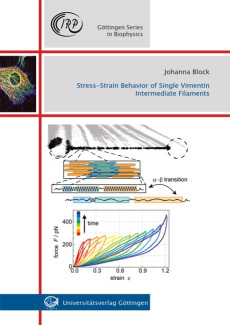Johanna Lena Block
Stress-Strain Behavior of Single Vimentin Intermediate Filament
Reihe: Göttingen Series in BiophysicsCells are the basic unit of living organisms and consist of a cytoplasm, which is enclosed by a membrane. As building blocks of life with a plethora of functions, cells have to be equipped with a high degree of mechanical resistance, durability, and variability. In eukaryotic cells three filamentous protein types – actin filaments, microtubules, and intermediate filaments (IFs) – form the so-called cytoskeleton, a network that is known to play a key role for the mechanical properties of cells. Among the three filament systems, IFs are special in terms of, for example, their hierarchical architecture, and their cell-type specific expression. In this thesis, vimentin, an IF mostly found in mesenchymal cells, is studied as a model system to learn more about the mechanical properties of IFs, and the underlying mechanisms that determine their robustness, stiffness, and flexibility. Using a combination of optical trapping and atomic force microcopy experiments and stochastic and numerical modelling, vimentin is found to possess impressive physical properties, such as an extendibility of about 3.6 times its initial length and a tensile memory that can be directly linked to the molecular architecture of the protein and the hierarchical construction of the filament. The experimental results show a clear loading-rate- and strain-dependent behavior of single vimentin IFs supporting the hypothesis that vimentin acts as a “safety belt” for cells, protecting them especially at large and fast deformations. The potential to dissipate a large amount of energy that is attributed to distinct non-equilibrium unfolding and refolding of the α-helices, which are the main structural feature of the vimentin monomer, enables vimentin to act as a shock absorber when exposed to large deformations. In case of cyclic deformations, such as in the cardiovascular system, the observed tensile memory could potentially help cells to be compliant with the repeated strain. In conclusion, vimentin is found to display highly interesting and diverse mechanical properties depending on the applied stress that could be linked to the molecular architecture of the filaments and enable vimentin to determine the mechanical properties of cells to a large extend.

